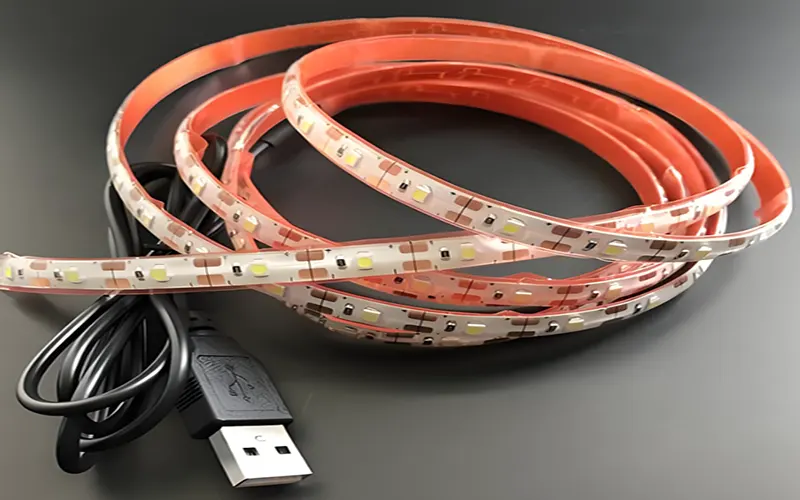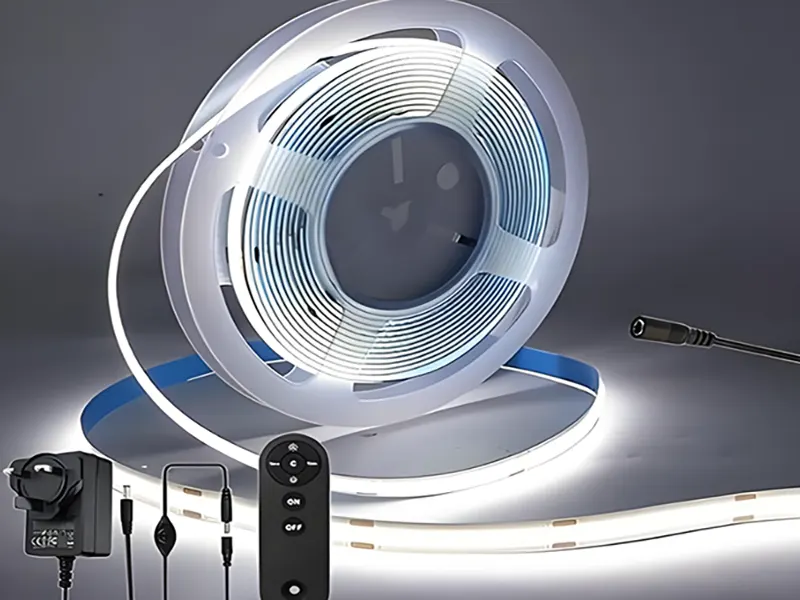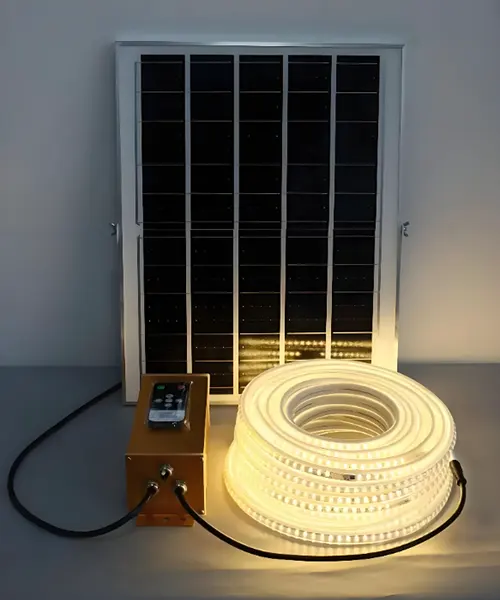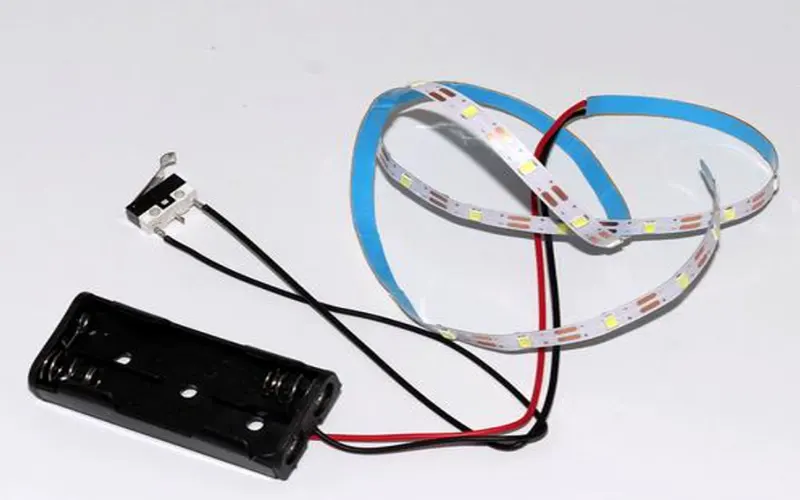We all know that low-voltage LED strip lights, whether 12V or 24V, require a power supply to convert AC mains power. Therefore, during installation, we need to plan the power supply location in advance and conceal it. However, in some places, such as bookshelves, display cabinets, or bedroom feature walls, we only discover after installation that the nearest power outlet is several meters away. Would we consider running extension cords? Unsightly and dangerous. Rewiring? A massive undertaking and impractical. At this point, a question naturally comes to mind: how do you light an LED strips light without a plugs?
The answer is: absolutely! And it’s a flexible solution that revolutionizes traditional lighting! However, it’s only suitable for small home projects. This article will answer this question in detail, showing you how to use the LED strips without plugs, their power supply types, and their best application scenarios.
Why Might LED Strips Not Come With the Plugs?
LED strips are typically sold in rolls or strips, usually with direct wiring for easy power connection. Therefore, not all LED strips come with a plug. Here are some common reasons:

- Custom Length: Some LED strips are custom-made to meet customer needs. Different lengths require different installation methods depending on the actual usage, and they are generally connected to a power source.
- Installation Flexibility: Plug-less LED strips offer greater installation flexibility. Users can choose the appropriate power connection method according to their needs (e.g., using different types of power adapters or directly connecting batteries).
- DIY projects and professional applications: Many DIY enthusiasts or professionals choose LED strip lights without plugs when installing them, depending on space requirements. They can control the connection method and power supply according to their own needs.
What are the Power Supply Types for LED Strips Without Plugs?
LED strips without plugs require alternative power sources to adapt to different installation environments and usage needs. Another reason is that AC mains power varies from place to place, and low-voltage LED strips cannot be directly connected to AC mains.
Therefore, LED strips without plugs power supply methods offer users greater flexibility and convenience. Below are some common plug-less LED strip power supply methods, along with their respective advantages and disadvantages.
Connecting LED Strips via USB
Powering LED strips via USB is one of the most common plugless power supply methods, but it’s limited to homes, offices, and other locations requiring low-power lighting.
USB power is convenient, and many electronic devices, such as computers, TVs, and power banks, already have USB ports, making it a very simple option. However, it’s not suitable for long distances.

Advantages:
Powering LED strips via USB offers several advantages. The main benefits are convenience, ease of use, and space saving. Devices like TVs and power banks provide USB ports, directly powering the LED strips without the need for additional plugs or power adapters, making installation very simple.
Furthermore, USB-powered devices are typically small and lightweight, saving space and making them suitable for limited areas. This allows LED strips to be used without being limited by fixed sockets, facilitating portability and temporary use.
Disadvantages:
Powering LED strips via USB also has significant drawbacks. The main limitations are power consumption and the inability to operate for extended periods. Because USB ports typically have lower current and voltage, USB-powered LED strips are generally suitable for low-power applications. For longer or higher-brightness strips, USB power may not be sufficient, potentially leading to decreased brightness or device overload.
Furthermore, prolonged high-load use of USB power can cause overheating in computers, televisions, or power banks, affecting device lifespan.
Using a Portable Power Bank
Powering plugless LED light strips with a portable power bank (such as a power bank) is a very flexible and convenient method. It’s primarily suitable for temporary outdoor use, as well as for temporary lighting or environments where access to traditional power sources is inconvenient.
Advantages:
Powering LED strip lights with a portable power bank eliminates the need for a fixed outlet. Simply carry the power bank to power the LED strip anytime, anywhere, making it especially suitable for outdoor camping and in-vehicle use.
Furthermore, portable power banks are small and portable, providing power to LED strip lights on demand, ideal for locations requiring flexible lighting arrangements.
Disadvantages:
Portable power banks have limited battery capacity, suitable for short-term power supply to LED light strips, but insufficient for long-term lighting needs. As the power of LED light strips increases, battery life decreases significantly.
We also need to charge the power bank regularly, especially during prolonged use, as the battery may deplete quickly.
Using a DC Power Adapter
A DC power adapter provides stable voltage and current to LED strips, offering an efficient and common power supply method, especially suitable for LED strips requiring high power. It ensures consistent brightness and operating efficiency throughout use.

Advantages:
DC power adapters provide a stable current to LED strips, suitable for long-term operation and avoiding the impact of voltage fluctuations on strip performance.
Furthermore, the adapter’s current and voltage stability makes it ideal for applications requiring continuous, long-term lighting.
Disadvantages:
Unlike USB power, DC power adapters require a power outlet to connect to a source of power, which will definitely limit their use in environments without outlets.
Furthermore, selecting the right DC power adapter for your LED strip specifications may require some technical knowledge; an incorrect adapter may cause the LED strip to malfunction or be damaged.
Using Solar Panels
Solar panels, as a green and environmentally friendly power source, are ideal for outdoor and remote lighting applications. They utilize solar energy to power LED light strips, making them a sustainable and environmentally friendly option, especially suitable for environments without external power access.

Advantages:
Solar panels do not rely on the traditional power grid, providing power to LED light strips entirely through natural resources (sunlight), significantly reducing energy consumption and aligning with green environmental protection principles.
It is primarily used for outdoor garden lighting, avoiding the inconvenience of power supply. Powering LED light strips with solar panels requires no connection to sockets or batteries; they are self-sufficient and rely entirely on natural light.
Disadvantages:
Solar panels rely entirely on sunlight for power. Cloudy days or insufficient sunlight will affect power output, causing the LED light strips to malfunction.
While solar panels are sustainable, under low light conditions, the amount of electricity stored in the batteries may not be sufficient to support long-term use.
Using Batteries
Battery-powered LED strips are another common plug-free power supply method, particularly suitable for scenarios requiring flexible installation. For example, they are very convenient for small outdoor events or temporary decorations.

Advantages:
Battery-powered lighting does not rely on power outlets, making it suitable for temporary lighting or locations where power access is inconvenient, such as outdoor camping, vehicle interiors, and emergency lighting.
Because the battery is an independent power source, it can be installed in various environments, especially suitable for temporary or non-fixed installation needs.
Disadvantages:
Batteries have limited power and cannot be used for extended periods; they need to be replaced regularly, otherwise the performance of the LED strip will be affected.
Batteries used in LED strips are also unsuitable for long-term projects. When the battery is depleted, it may require recharging or replacement, increasing maintenance costs and workload.
Where are LED Strips Without Plugs Best Suited?
Plugless LED strip lights offer high flexibility and convenience, making them suitable for a variety of occasions and applications. Since some installation locations genuinely lack electrical outlets, these plugless LED strip lights are a viable option. Here are some scenarios where plugless LED strip lights are most suitable:
Outdoor Lighting
Plug-free LED light strips are ideal for outdoor use, especially in places like camping, garden lighting, and bonfire parties. They can be temporarily powered by batteries and solar panels, providing environmentally friendly and convenient lighting.
Home Decorative Lighting
Plug-free LED strips are ideal for decorative lighting in homes or commercial spaces. They add color to spaces without outlets, such as bookshelves, behind TVs, etc. We can all use them for lighting.
Temporary Lighting
When you need temporary lighting, especially when it’s inconvenient to use it outdoors, plugless LED light strips are a great option. For example, when using LED light strips in garages, toolboxes, kitchens, or temporary workbenches without power outlets, you can choose to use a power bank or batteries.
Travel and In-Vehicle Applications
Plug-free LED light strips are also suitable for travel, camping, and in-vehicle applications. Connecting via USB or using a power bank, car owners and travelers can provide additional lighting for their vehicles, tents, and more.
DIY Projects
DIY enthusiasts often choose plugless LED light strips, especially for personalized designs and custom installations. Primarily used for decoration and outdoor applications, they offer flexible configuration options for DIY projects.
Conclusion
LED strips without plugs offer users greater flexibility and convenience, suitable for various environments and needs. They are not just a simple lighting channel requiring a power supply, but provide a highly practical option for home, outdoor, commercial, and DIY projects.
If you are looking for a more flexible and personalized lighting solution, plug-free LED light strips are an ideal choice. Contact us for customizable LED strips in various lengths and color temperatures.
FAQs
Yes. As long as the charger’s output specifications match the strip’s requirements (usually 5V/1A or 2A), it can be used directly. Be sure to use a reputable brand charger to ensure safety.
While plugless LED light strips offer great flexibility, it depends on how you use them. USB or battery-powered strips offer greater flexibility, suitable for homes, offices, vehicles, or outdoor activities. However, if you choose a DC power adapter or solar panel, you’ll need to consider power availability, such as the need for an outlet or sunlight.
Solar panels are suitable for outdoor use or areas without power access, primarily for outdoor lighting, such as patios, gardens, and terraces. They are best suited for low-power, long-running LED light strips.
LED strip lights without plugs usually come with bare wires or terminal blocks, requiring you to use a suitable power adapter or battery to connect. Of course, you can also connect directly to a power source, which is the most convenient and straightforward method.
Generally, yes. Due to the limited voltage and current output of batteries and USB power supplies, plugless LED strips often have a lower maximum brightness (lumens) than high-power 12V/24V LED strips that are directly connected to a wall socket.
